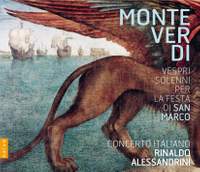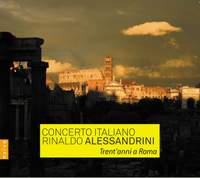Interview,
Rinaldo Alessandrini
 Rinaldo Alessandrini is probably the world's foremost expert on Monteverdi and the Venetian school; his recordings of music of this period with the ensemble Concerto Italiano (which celebrates its 30th birthday this year) have garnered praise from experts and listeners alike among the early music community.
Rinaldo Alessandrini is probably the world's foremost expert on Monteverdi and the Venetian school; his recordings of music of this period with the ensemble Concerto Italiano (which celebrates its 30th birthday this year) have garnered praise from experts and listeners alike among the early music community.
His latest release constructs an imaginary Vespers for San Marco, drawing on Monteverdi's vesper psalm settings and other music from this period; it also includes a bonus DVD containing a short but fascinating documentary that sheds further light on the project.
I caught up with him via email to delve deeper into the thinking behind this bold and imaginative project (and some of his broader research into the world of Renaissance Venice).
This album brings together movements from various of Monteverdi’s large-scale choral works and collections. What was your thinking behind these juxtapositions – were you attempting to recreate a specific historically-attested event, or a hypothetical one? >Collections such as ‘Selva Morale’ feature liturgical music, not merely concert music. Music which was used based on the needs of breviaries and antiphons across different eras and different locations. Paradoxically, the reconstruction of a Vespers ceremony is the most “authentic” way to perform this kind of music correctly. The performance of these pieces in isolation from a liturgical structure decontextualizes them from both a formal and a rhetorical point of view. Listening to the architecture of a ‘Magnificat’ at the end of a liturgical session is the only way to prove the logic behind such a manifestation of musical and creative strength. We don’t have any evidence about the order of the pieces on the recording, but we do know how these functions were celebrated and what criteria were used to highlight the importance of the event.
How did you decide which psalms to include – or to put it another way, why did you use psalms only from the Selva Morale and none from the 1610 Vespers? >Our intent was to recreate a Venetian Vespers, performed in San Marco. Nowadays we know that 1610 Vespers were firstly dedicated to S. Barbara, and performed in Mantua in the main Basilica, when Monteverdi was still in service. The 1610 Vespers, along with more traditional mass ‘In Illo tempore’, were published in honour of Pope Paul V, this time with a new and more popular dedication to Blessed Virgin, with the aim of favouring Monteverdi’s hiring in Rome. The mass, in stile osservato, was the piece dedicated to the appreciation of the pope; the Vespers on the other hand, written in concert style (in stile concertato), served instead to attract sales of the edition.
>To this end, the first edition of the Vespers was modified with the insertion of non-structural instrumental interventions (Dixit) or of brand new pieces. The Magnificat, originally with 6 voices, was extended to 7 voices with the addition of instruments. We don’t have evidence of any performance of the 1610 Vespers in the Basilica of San Marco. The need to resort to the responsory of the 1610 Vespers in the recording was due to the lack of a composition in figurative style of this text. But the ‘Selva’ presents Monteverdi’s Venetian production (from 1613) and it as therefore only logical to refer mainly to this collection.
You insert motets and Gabrieli instrumental sonatas after each of the psalms that comprise the bulk of the Vespers service. In the 1610 Vespers Monteverdi himself does exactly this, but even there their function and order is a matter of some doubt – so how did you decide which pieces to add to the album, and where to place each one? >The function of sonatas and motets is to substitute the repetition of antiphons: “in loco antiphonae” as one would have said at that time. The ‘concert’ music of the 1610 Vespers, which should have substituted the antiphons, in truth weren’t part of the Madonna’s liturgy: some (such as the “Duo Seraphim”) have instead been recognised as being part of S. Barbara’s liturgy. In any case, the order of publication of the 1610 Vespers represents a false problem: Monteverdi’s intention wasn’t to provide a musical service for the Holy Virgin’s Vespers but merely to drive publication of the Mass ‘In illo tempore’. The presence, the quality and quantity, of ‘concert’ music is completely random and likely a response to editorial opportunities/needs.
Some of the pieces – in particular the Beatus Vir – have a rather more prominent brass presence than is usually heard. What was the thinking behind this – is it related to the use of wind instruments to represent “power and majesty”, that you mention in the documentary? >The greater or lesser use of instruments in Venice’s musical and liturgical culture was related to the greater or lesser importance of the event. It’s safe to say that the celebration in San Marco in Venice would have been an ostentatious event with a large number of singers and musicians. The use of musical instruments has rhetorical connotations to sacred and divine symbolisms; in the Catholic culture of the 17th century, music was a reflection of life’s blissfulness after death. As such, the didactic intent pursued by the Catholic leaders could only be fully achieved through majestic, acoustic celebrations in order to best convince believers to stay devoted to Christian principles and to stay faithful to the representatives of the church.
In the documentary, you also try out some recreations of 17th-century dishes with Francesco Antinucci – are any of them any good? >The recipes were all extremely pleasant, mainly characterised by a blend of sweet and savoury flavours together: typical of the cuisine of the Renaissance era across the whole of the Italian peninsula.
'Vespri solenni per la festa di San Marco' is released on Naive on 26th August.
Available Formats: MP3, FLAC, Hi-Res FLAC
Recent recordings by Rinaldo Alessandrini and Concerto Italiano
To celebrate the 30th anniversary of his ensemble Concerto Italiano, Rinaldo Alessandrini has chosen some of the greatest moments from their rich discography. Released 26th August
Available Formats: MP3, FLAC
A new recording of what is considered as the first opera: 'L'Euridice', by Caccini. Conducted by Rinaldo Alessandrini and featuring an impressive range of singers (Sara Mingardo, Furio Zanasi, Silvia Frigato and others), this very special work was staged and performed at the 2013 edition of the prestigious Innsbruck Festwochen.
Available Formats: MP3, FLAC





